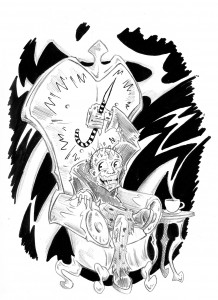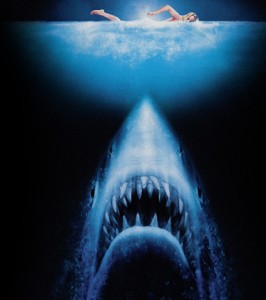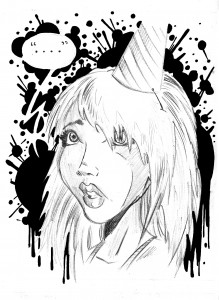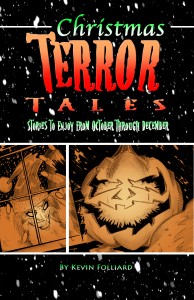Hey Horror Fans!
`
I promised I would write more about the actual craft of writing on my blog, and not just throw thinly veiled Christmas Terror Tales advertisements in your face! Consider this a compromise.
‘
In previous posts, I’ve simplified fiction writing as experiences filtered through your brain, pulled apart, and stitched back together. The best part is the experiences don’t even have to be your own. Books you read, movies you saw, and things that happened to you or people you know can all be reworked and reimagined. You hear it all the time: good writers draw inspiration, great writers steal.
`
Crafting a short scary story is the same, and anybody can do it. So here is my humble perspective on how to write one in four stages.
Stage 1: Have a Concept
`
Every story starts with an idea. It doesn’t even have to be a good idea. Seriously. I personally work better telling myself that there’s absolutely no way I’m ever going to come up with something original. It’s all been done. Relax. The originality comes naturally because we all have unique interpretations, vocabularies, and perspectives.
`
Just have a concept. Know that you want to write a certain kind of story, or even just a story about a certain kind of thing. Have a main goal, and sweat the details later.
Scary stories do not have to be genre transcending literary masterpieces. They just have to have a singular effect that will work on your audience. They may or may not have twists. They may or may not be surprising. They may or may not even be scary. What they should have is some kind of hook, and an action or event that moves the reader on more than one level.
`
In writing Christmas Terror Tales I had a specific built in premise. They all had to be short, precise stories; and they all had to have some kind of Christmas, winter, or holiday gimmick. Some of the concepts came more naturally than others, but my most useful tool was my brainstorming list of conventions and gimmicks. I knew somewhere in my collection of scary stories I wanted there to be one about a snowman. I knew one had to have a Jack-O-Lantern. I decided it would be cool to have one about the Nativity Scene. Growing up as a good God fearing Catholic boy, I thought the devil was really scary. So in he went.
`
What did I think was scary? What did I know other people thought was scary? What did people think of when they thought of Christmas? How could I turn those holiday conventions upside down? I told myself that every story that made it in absolutely had to have two gimmicks: Horror and Holiday.
`
This whole notion of combining ingredients can work for just about any kind of scary story you’re writing. What’s a tried and true convention of horror? What’s something else that people might not fear or associate with horror? Smoosh them together. It’s certainly not the only way to write a story, nor is it the only way I come up with ideas. But it works.
Just have an idea. Don’t pressure yourself to be brilliant. Brilliance rarely strikes, so if you want to be a writer, make peace with that and start generating material. A lot of literary people might turn their noses up at that word: gimmick! But gimmicks make the world of fiction go round. What do you think people were talking about when they first saw Jaws in 1975? I’ll give you a hint: it was a shark! Not a genre transcending diatribe about primordial fears and the struggle between Jungian baloney and psychological who-gives-a-fig. It was a shark that ate people.
,
Not every horror fan will agree with me perhaps, but to me stories are scarier when they’re raw. And part of that rawness comes from the simplicity of that initial concept. Have a good “what if…” and don’t overthink it. Just try to flesh it out into a story. The complicated psychology of your story can (and I like to think should) rise up around your characters and premise naturally.
,
Outlining is a great tool for conceptualizing as well. Sometimes I outline a story before I write it. Sometimes I don’t because that raw concept explains everything I need to know to write a draft. But either way, I try to be flexible. Make an outline to figure out who’s in your story and what happens, but have fun as you write your first draft too. Chances are you’ll come up with a better idea after you’ve outlined… or in many cases after you’ve rewritten your story ten times.
,
Like anyone, I have lots of ideas that go nowhere. No problem, some ideas pan out and others don’t. The more you explore the more likely you are to find one that clicks.
,
Stage 2: Write a Draft
,
Writing a scary story is actually a lot like telling a joke. There’s a setup, there are one or more events, and there’s a disturbing or frightening “punch line.” Many jaded or seasoned horror fans will see these conclusions coming and they won’t be scared. Don’t worry. Most of them still enjoy the ride.
,
When writing that first draft, don’t be alarmed if things don’t come out right. That’s what revision is for. A lot of people are afraid of the “blank page.” They hate that whole part where you supposedly “make something from nothing.” Fear not! That initial concept you came up with is your security blanket, and it tells you enough about what has to happen to get moving.
,
Scary stories can be simple in their effect and thus can be sparse on words and details. I’ve read one-page stories that were much better than whole novels or feature length movies. Dressing things up with lots of bells and whistles in my experience can be fun, interesting, or even impressive. But it’s not the part that makes something scary. The scary part is making your reader buy into the events of the story. It’s making them afraid that the same thing could happen to them… even if they know logically it isn’t likely to. In order to accomplish this, I’ve found that less is more. It’s not a perfect rule of thumb, and yes longer pieces can be effective in their terror; but don’t overthink the backstory and the details. Just tell us about something awful.
,
Horror comes in many forms, but the short scary story is unique because people can tell it around a campfire, remember, and retell later. Hollywood horror doesn’t do that. Novels don’t either. Don’t think your short story isn’t scary because it’s not building an elaborate universe around its characters. The universe and the backstory aren’t ever scary and they’re not essential.
,
You know you’ve gotten to the end of your story when you’ve reached the scariest or most horrifying detail. Again, it’s like a good joke. You don’t keep explaining the joke after you’ve reached the punch line. It’s over. If you keep explaining the “aftermath” of events, what you reveal to your reader may be less frightening than where their imagination might have taken them if you just left things up in the air. Like any good performance you end on a high note. Ironically, when telling a scary story the “high note” is usually the worst thing possible.
,
M.R. James is a turn of the 20th century writer I recently discovered who specialized in ghost stories, and I really wish I had found him sooner. He provided excellent criteria that I plan to use to evaluate my short horror fiction going forward. According to Mr. James, scary stories should have the following…
.
The Pretense of Truth: Ever notice how urban legends spread like wildfire… because people think they’re true (which sometimes they are.) Ever notice how disturbing news stories, documentaries, or “real life” investigations of the paranormal (shows like Unsolved Mysteries) tend to resonate with us? We are more afraid if we think something’s real. Now that doesn’t mean that modern scary stories have to start with that bold assertion: “this is true!” But verisimilitude matters.
,
Write it like it’s real, treat the characters like real people, present it as something that might happen to the reader, and don’t overthink the details. Scary things are things that happen to normal believable people. If all the characters in your story are vampires, it might be fun, but it won’t be scary.
,
“A Pleasing Terror”: This is one of Mr. James’s vaguer criterions and I’d be interested to hear more about what he thought this meant. But the general message is this: write a story that people can be afraid of from the comfort of their safe and happy home. Scary stories should allow readers to live vicariously through the adrenaline rush of the events. They should make the reader’s skin crawl, but not make them literally want to vomit. There are some places that are just so dark and disturbing that using them to “scare” people is just too easy.
Example: “The Human Centipede” isn’t a scary movie… it’s just sick and disturbing. There is a difference. The “Torture Porn” sub-genre of Hollywood Horror is a great example of the kind of terror that really doesn’t “please” its audience. It’s horrible, it’s disturbing, but it’s not scary. You could write all sorts of stories that disturb people deeply and take us to extremes of disgusting that would make our grandmothers cry, but that doesn’t make your story scary. It’s too easy, and it’s not really effective because it’s usually so outlandish that people know it’ll never happen to them.
,
Develop a “pleasing terror,” something that people will want to read about. Something that will keep them in suspense. Something they can be scared of in a fun, or at least reasonable, way. I could write a story about a man who eats a woman’s baby in front of her face while she is helplessly chained to a wall. But that’s not scary. It’s just terrible.
,
No Gratuitous Bloodshed or Sex: Gotchya again Hollywood! Too much sex and gore makes things less scary. Avoid it, especially if you want to attract young readers.
,
Should violent things happen in a horror story? You bet! Should we describe the blood, brains, and puss in visceral detail… well you can if you want. But that doesn’t make it scary. It just makes it gross. Again, there are many fun sub-genres of horror and “bloody” certainly has its audience. Just don’t mistake gratuity for scary. Less is almost always more.
,
No “Explanation of the Machinery”: This is a great rule of thumb! It mostly applies to the paranormal, but it works across the board. Don’t overexplain. Things are scarier when they’re mysterious. It’s like a bad prequel. The more we learned about Darth Vader the less cool he became as a badguy… until he wasn’t a badguy at all. Just a whiny little punk. Scary stories loaded with backstory, details, and elaborate plot points or author-invented mythology are almost never scary. If you explain what a ghost is, or explain exactly where vampires came from and what they “really are” people will never be impressed.
,
Okay, so millions of Twilight readers are proof that they might be impressed. But I guarantee you they won’t be scared.
,
Set the story in contemporary times: Here’s a big one. It’s great fun to write period pieces, or stories about alternate or future worlds. But rarely are those stories scary. Almost never. Because the reader is so far removed from the element of terror that they can’t make that crucial connection “this could happen to me.” I’m not afraid of vampires in Victorian London any more than M. R. James was afraid of the ghosts of people who hadn’t been born yet in 21st Century Chicago. Many terrific sci-fi or historical fiction stories exist, but the ones that can scare the audience are exceptions.
,
Five great rules that I intend to hang onto for my next batch of scary stories! And in retrospect, I think CTT measures up to Mr. James’s criteria pretty well.
,
Again, not every scary story will affect every reader equally, so be thrilled if half your readers are scared. A great example is the CTT story “The Green Box.” I’ve gotten just about every comment ranging from not scary at all to deeply disturbing, and all the stuff in between. Don’t worry, lots of people are afraid of lots of different things and you’re not going to get everyone with one idea. Fiction is subjective and that’s a good thing. The more stories you write, the more you will start to strike those different chords with different people. I’ve had seasoned horror vets read my collection and tell me they liked half the stories. I take that as a tremendous compliment.
,
Just write a story that you know some people will find frightening. Get yourself a beginning, middle, and end. Once you’ve got that, you’re all set to start the long fun process of evaluation and revision.
,
Stage 3: Get Some Feedback
,
Some of us are really good writers and we can write perfect, flawless stories on the first try. Most of us aren’t though. And almost all of the writers who think they’re that good aren’t that good. So I would never publish something without getting a few second opinions. We tend to be the worst evaluators of our own work because we’re closest to it.
,
Some writers are lucky and work with agents, publishers, and professional editors. Most writers don’t get to. In fact with the changing publishing scene, the rise in legitimate self-publication, and the increasingly tightening circle of publishers who won’t take a chance on new authors… most of us have to do everything ourselves. That means editing, editing, and more editing.
,
Don’t get overburdened. Make friends. Ideally, join a local writers group. You might have to try a few before you find one you like. I’m very lucky and I found a great group of writers at my local library. They were instrumental in getting feedback and advice for Christmas Terror Tales. However, community writers groups often take time to get to your work. It’s a give and take relationship and you extend them the same courtesy that they extend you by reading and providing honest constructive criticism for their writing.
,
That meant in my case that I was only able to get about half of the CTT stories through the workshop before the deadline I had set for myself. As such, I turned to other writer friends outside the group. Friends who I knew enjoyed speculative fiction, and some friends who weren’t necessarily into horror… but none the less were great writers and had an eye for grammar and mechanics. Find people who will give you the honest truth about your writing. You won’t always like it, but you can always use those impressions to improve.
,
But by the same token… don’t be afraid to take some advice with a grain of salt. You have a better idea of what kind of audience you have in mind for your story. You have specific goals and a specific idea that you’re crafting. Some criticism will help you develop that and get you to where you need to go. Some criticism needs to be filtered, reflected upon, and reconciled.
,
Not everyone knows what’s best for your story so that’s why it’s great to have as many people check it out as possible. Exercise your power to veto a recommendation, just have a good reason.
‘
A good critic will usually account for this, but sometimes you have to adjust the feedback yourself. Just don’t go easy on yourself. I myself was stubborn about the ending of “Twelve O’Clock” in CTT. But after three or four people told me in a row that it was underwhelming I finally slapped myself and believed them. I took some suggestions, put my own spin on them, and came up with what I feel is a much improved ending to the original. But I never would have gotten there without my network of writer buddies.
,
Stage 4: Revise & Proofread
,
I prefer to do a few major revisions based on my own observations and editorial knowhow prior to turning to fellow writers. But one way or another, you get different (usually better) ideas out of a critique. Time to sit down and implement the ones you know are on the money.
,
Stage 4 is pretty cut and dry. Take the good advice you got and put into practice. Proofread for grammar and mechanics. Fiddle with your word choice, tighten your descriptions, strengthen your verbs. Blah Blah Blah. The best advice I give people on proofreading anything is to read out loud. Most people agree that it works, but don’t do it because they feel stupid reading something out loud to themselves. Just get over it. Reading out loud works, and it’s a lot easier to “hear” your own mistakes than it is to see them. I could write more about revision and proofreading, but let’s make a long story short. Perfecting writing is fun for some, boring for others. Either way, you gotta do it. Your story will never be perfect, but you should try anyway.
,
As my final word let me just say that the number one reason to write fiction is for enjoyment. If you’re writing to publish, more power to you, but why not write a scary story just to share with your friends and family? Make it short. Memorize it if you’re a good oral storyteller, and keep it in your back pocket. Scare your kids, scare your neighbors, terrorize your spouse or significant other. Post it online and guarantee your audience that your story is 100% “true.” You could be the originator of the next best urban legend! And to me, that would be far more impressive than publication!
Don’t forget to check out Christmas Terror Tales on Amazon, Facebook, and Goodreads.com! Plenty of copies of my book to give away, and cool prizes to win. Check out the links below. Happy holidays to all!
,
CTT on Amazon.com: http://www.amazon.com/Christmas-Terror-Tales-Stories-December/dp/1463786948/ref=sr_1_1?ie=UTF8&qid=1320704442&sr=8-1
,
CTT for Sale on Chicago’s South Side at Bookies: http://bookiespaperbacks.com/
,
CTT on Facebook (giveaways and trivia): http://www.facebook.com/pages/Christmas-Terror-Tales/204731106257625
,
Ongoing CTT Givaways at Goodreads: http://www.goodreads.com/giveaway/show/16570-christmas-terror-tales-stories-to-enjoy-from-october-through-december






One Response to Write a Scary Story in 4 Stages!